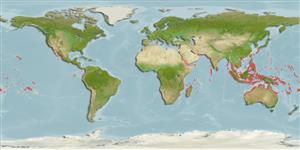Common names from other countries
>
Carangiformes (Jacks) >
Carangidae (Jacks and pompanos) > Trachinotinae
Etymology: Trachinotus: Greek, trachys, -eia, -ys = rough + Greek,noton = back (Ref. 45335).
More on author: Lacepède.
Environment: milieu / climate zone / depth range / distribution range
Écologie
marin; saumâtre récifal; profondeur 0 - 3 m (Ref. 89972). Tropical; 32°N - 32°S
Indo-Pacific: Red Sea to the Line and Mangaréva islands, north to southern Japan, south to Lord Howe and Rapa.
Taille / Poids / Âge
Maturity: Lm ? range ? - ? cm
Max length : 60.0 cm TL mâle / non sexé; (Ref. 4225); common length : 35.0 cm TL mâle / non sexé; (Ref. 5450); poids max. publié: 1.5 kg (Ref. 30874)
Épines dorsales (Total) : 7; Rayons mous dorsaux (Total) : 20 - 24; Épines anales: 3; Rayons mous anaux: 20 - 24.
Adults occur near surface waters of lagoon and seaward reefs, in surge zones along sandy beaches (Ref. 48635, 90102). They always move in schools at the edge of the surf near the reef, usually in pairs or small groups in surface waters (Ref. 48635). They feed on small fishes (Ref. 9710). They are occasionally taken by trolling and line fishing.
Life cycle and mating behavior
Maturities | Reproduction | Spawnings | Egg(s) | Fecundities | Larves
Paxton, J.R., D.F. Hoese, G.R. Allen and J.E. Hanley, 1989. Pisces. Petromyzontidae to Carangidae. Zoological Catalogue of Australia, Vol. 7. Australian Government Publishing Service, Canberra, 665 p. (Ref. 7300)
Statut dans la liste rouge de l'IUCN (Ref. 130435)
CITES (Ref. 128078)
Not Evaluated
Menace pour l'homme
Harmless
Utilisations par l'homme
Pêcheries: intérêt commercial mineur; pêche sportive: oui
Outils
Articles particuliers
Télécharger en XML
Sources Internet
Estimates based on models
Preferred temperature (Ref.
115969): 24.7 - 29.3, mean 28.4 (based on 3280 cells).
Phylogenetic diversity index (Ref.
82804): PD
50 = 0.5000 [Uniqueness, from 0.5 = low to 2.0 = high].
Bayesian length-weight: a=0.01259 (0.00582 - 0.02724), b=2.96 (2.77 - 3.15), in cm Total Length, based on LWR estimates for this (Sub)family-body shape (Ref.
93245).
Niveau trophique (Ref.
69278): 3.6 ±0.52 se; based on food items.
Résilience (Ref.
120179): Milieu, temps minimum de doublement de population : 1,4 à 4,4 années (Preliminary K or Fecundity.).
Fishing Vulnerability (Ref.
59153): Moderate vulnerability (44 of 100).
